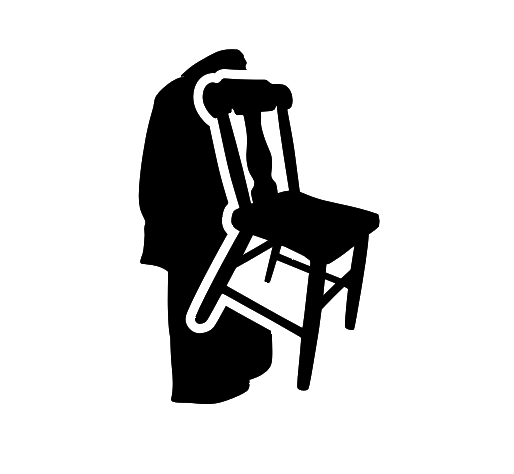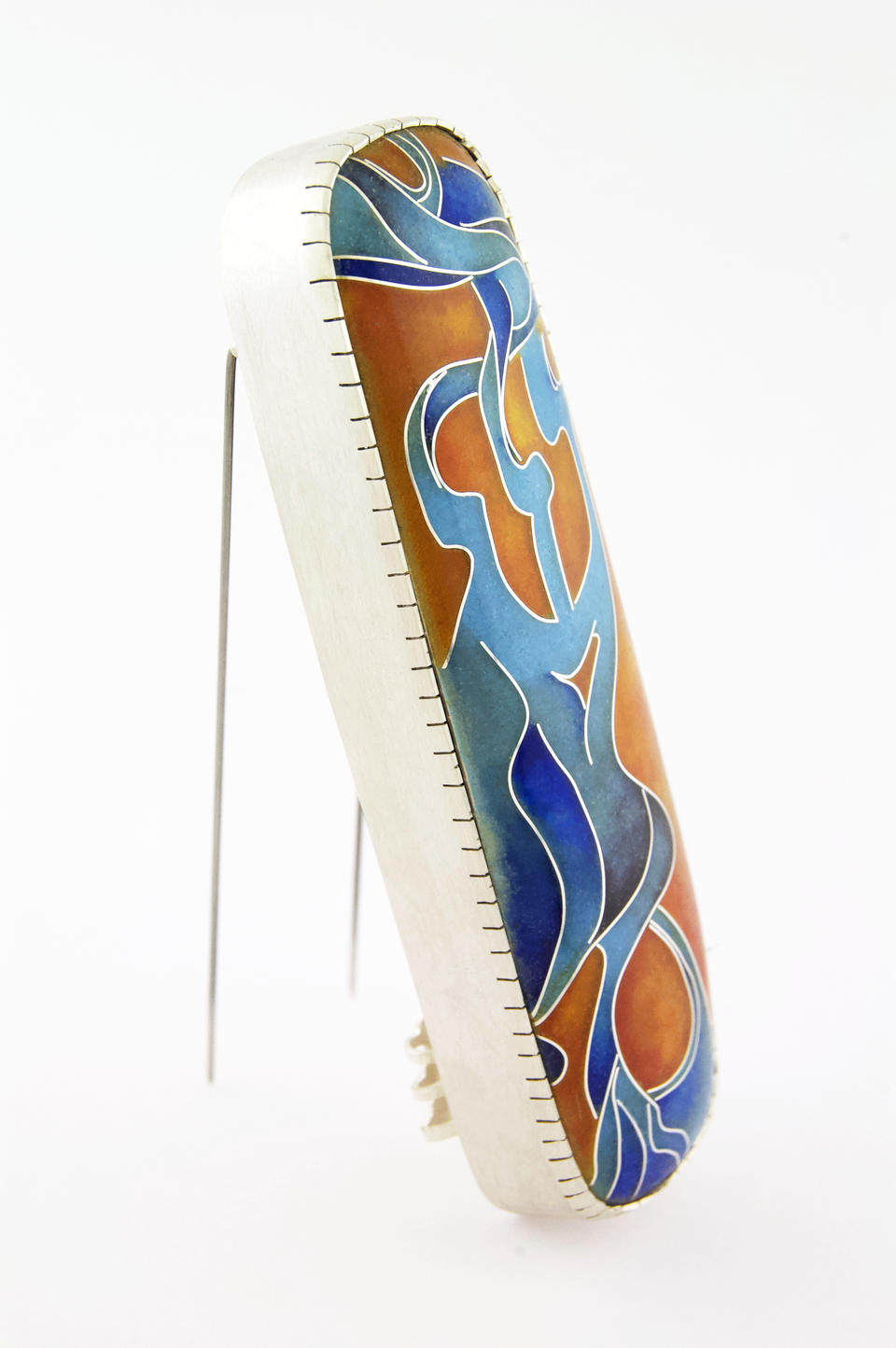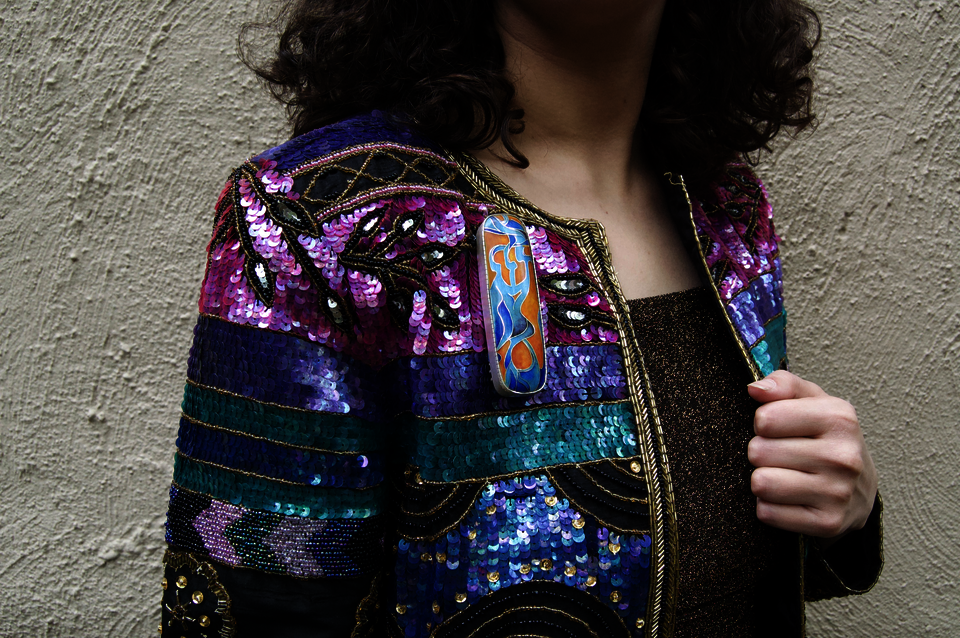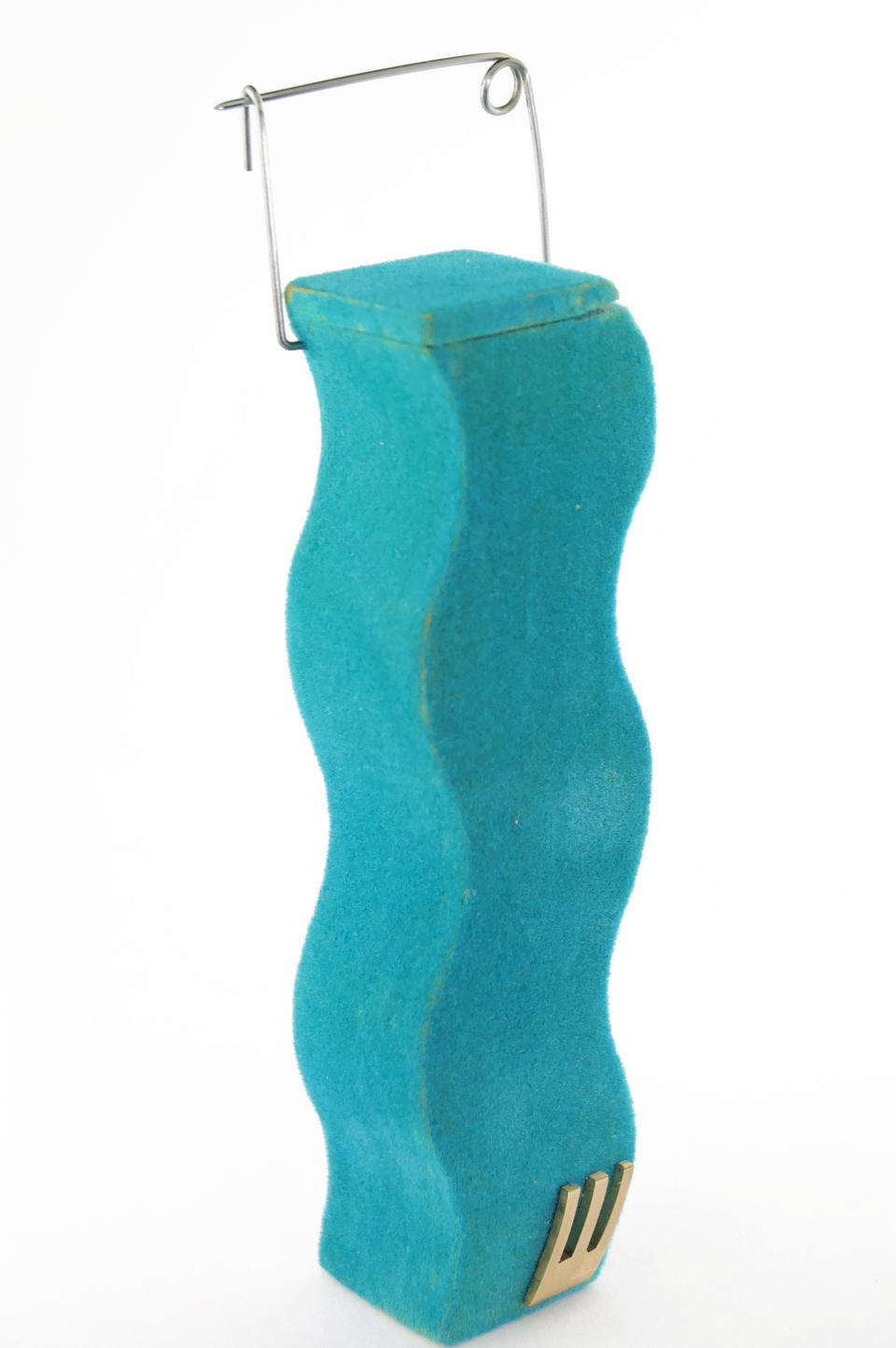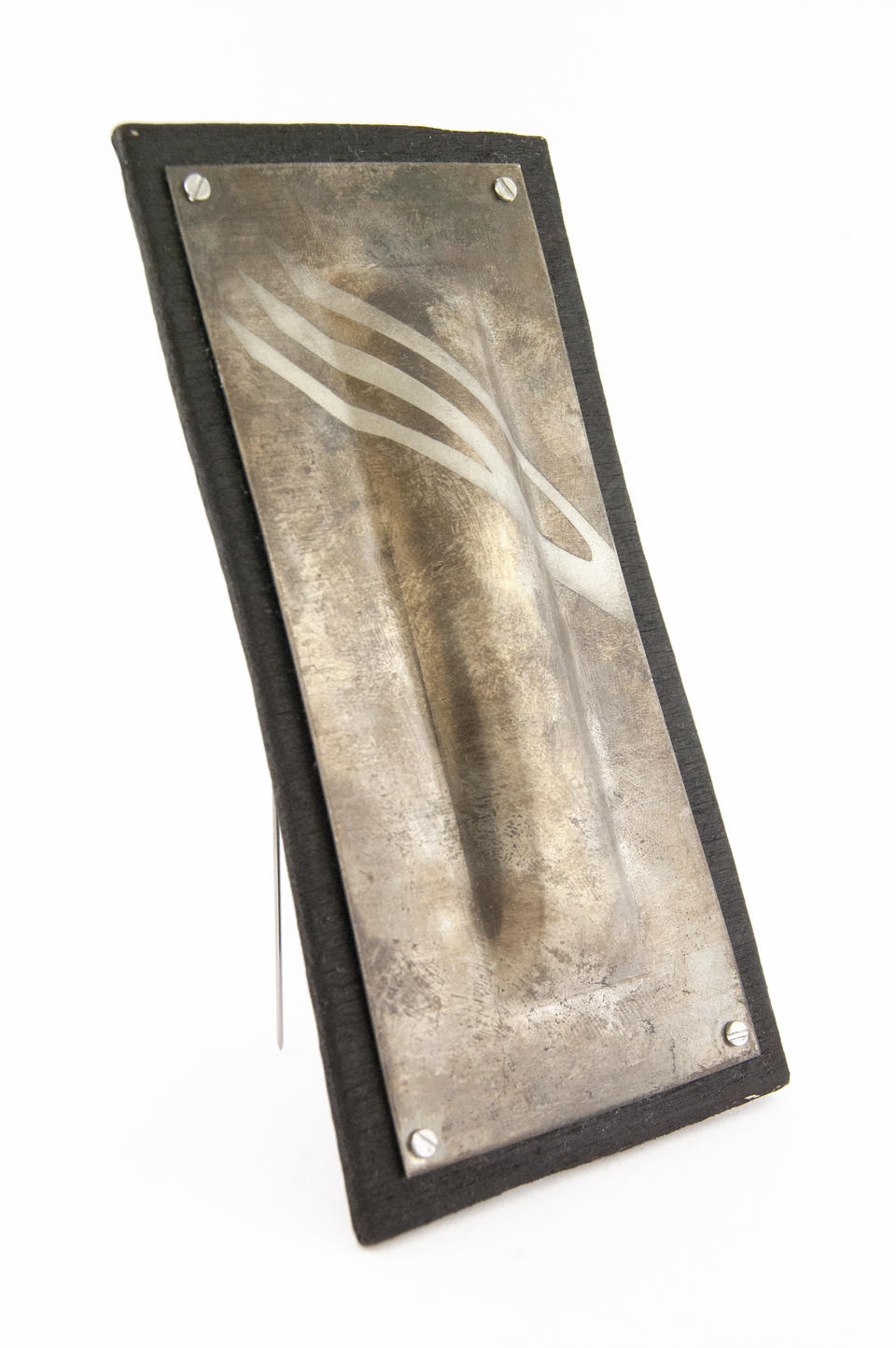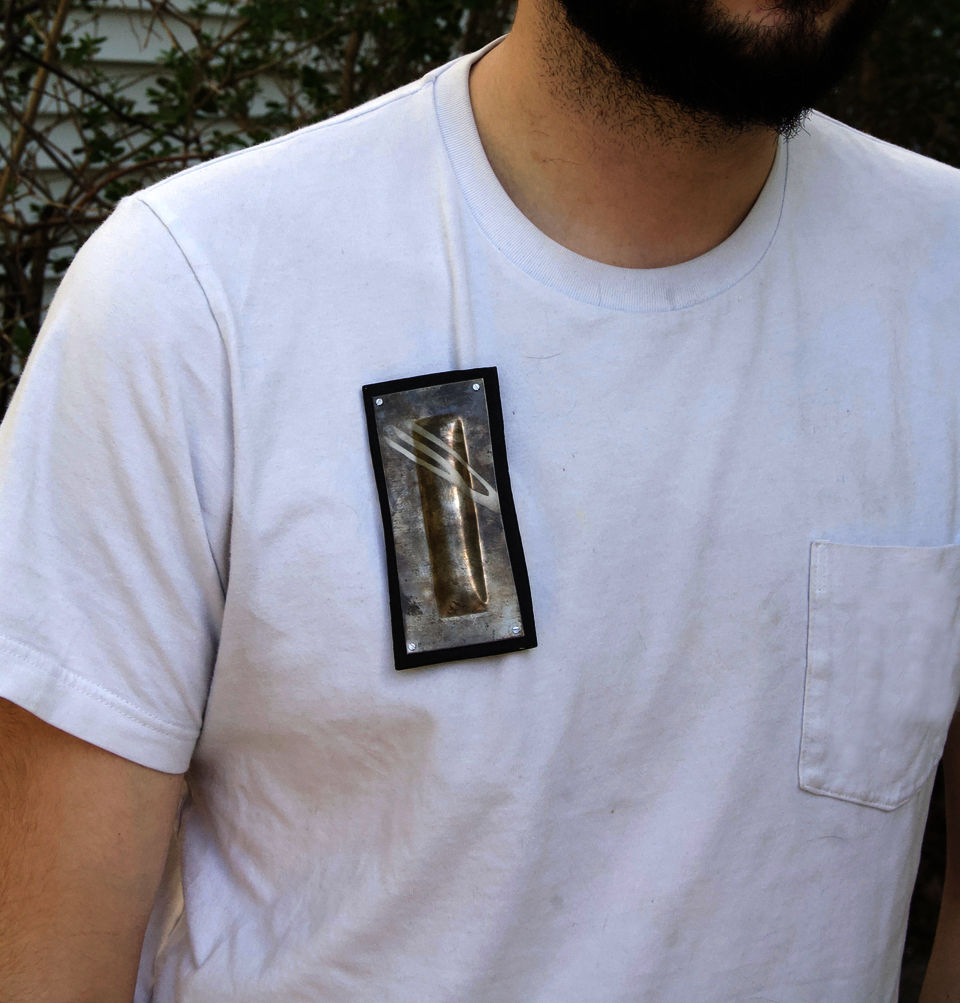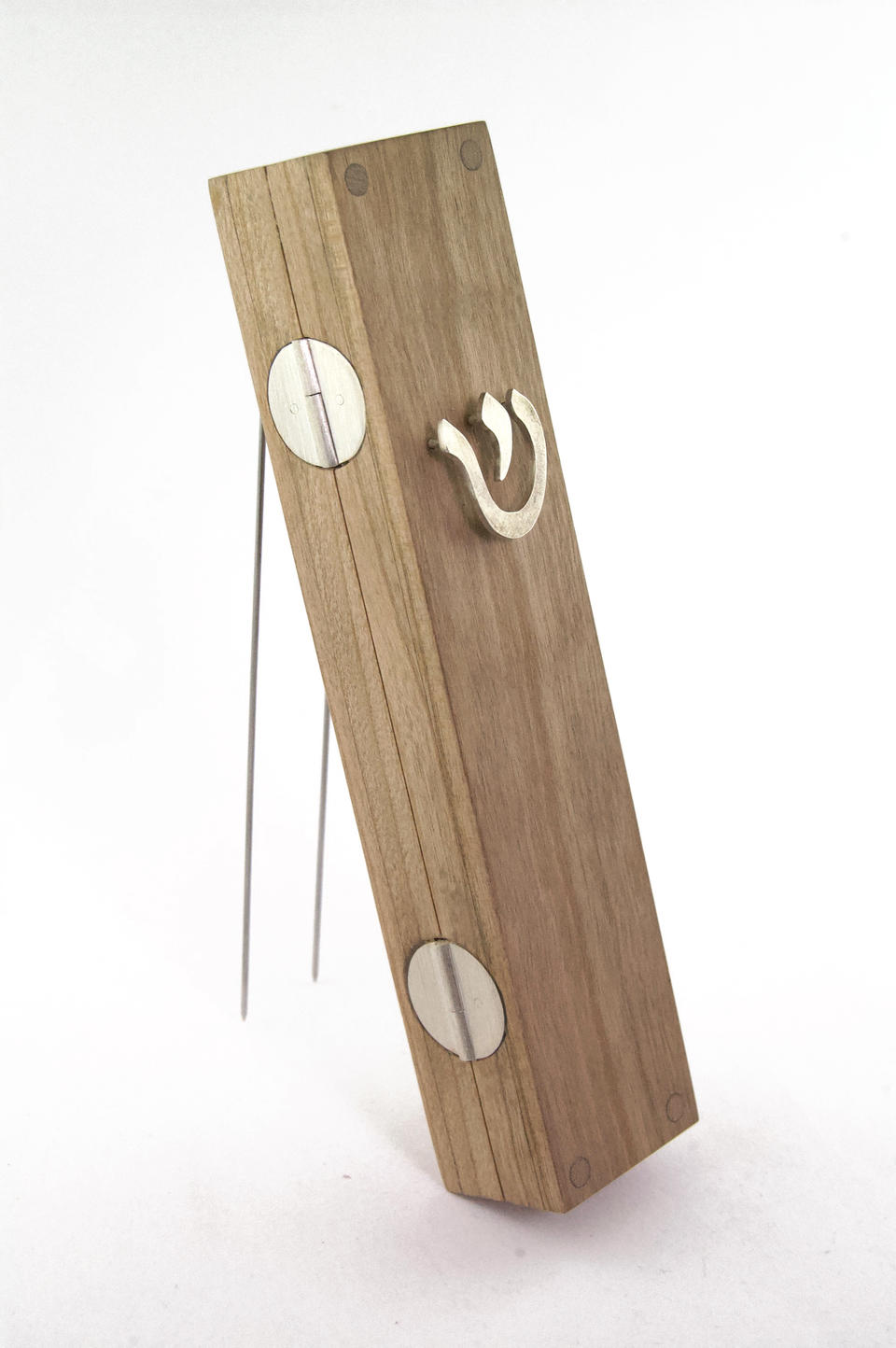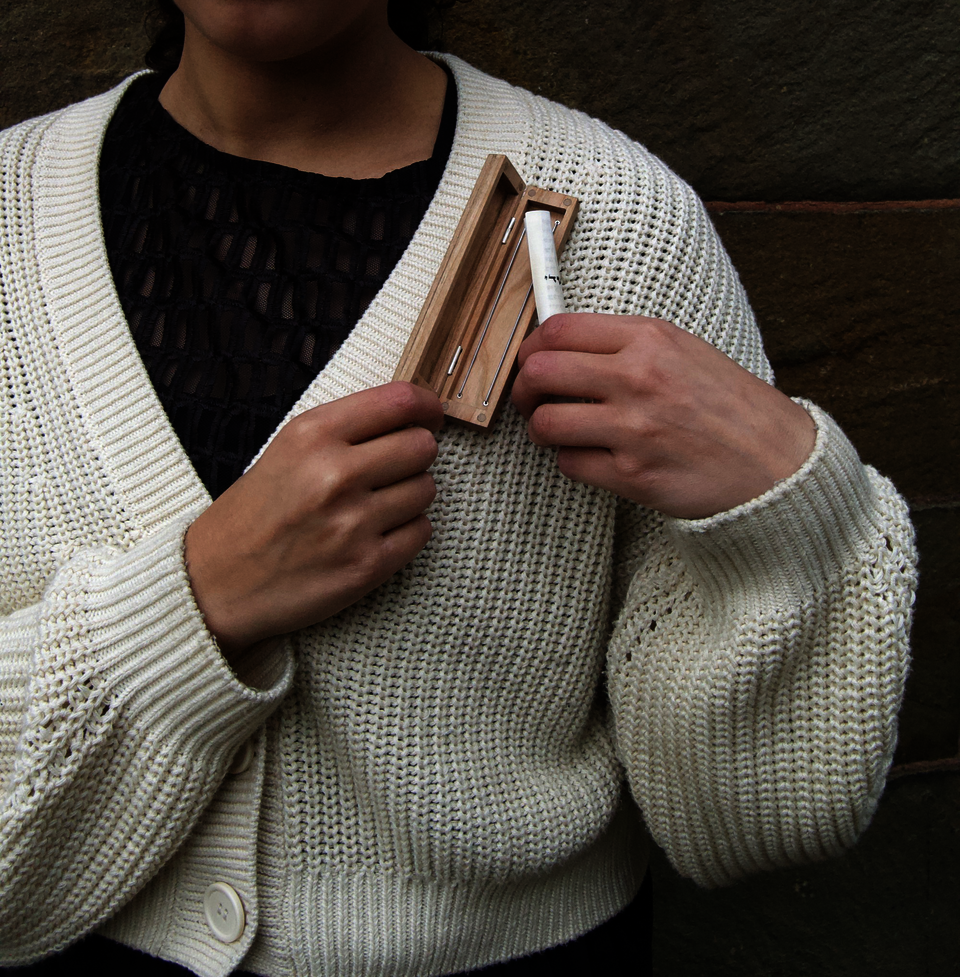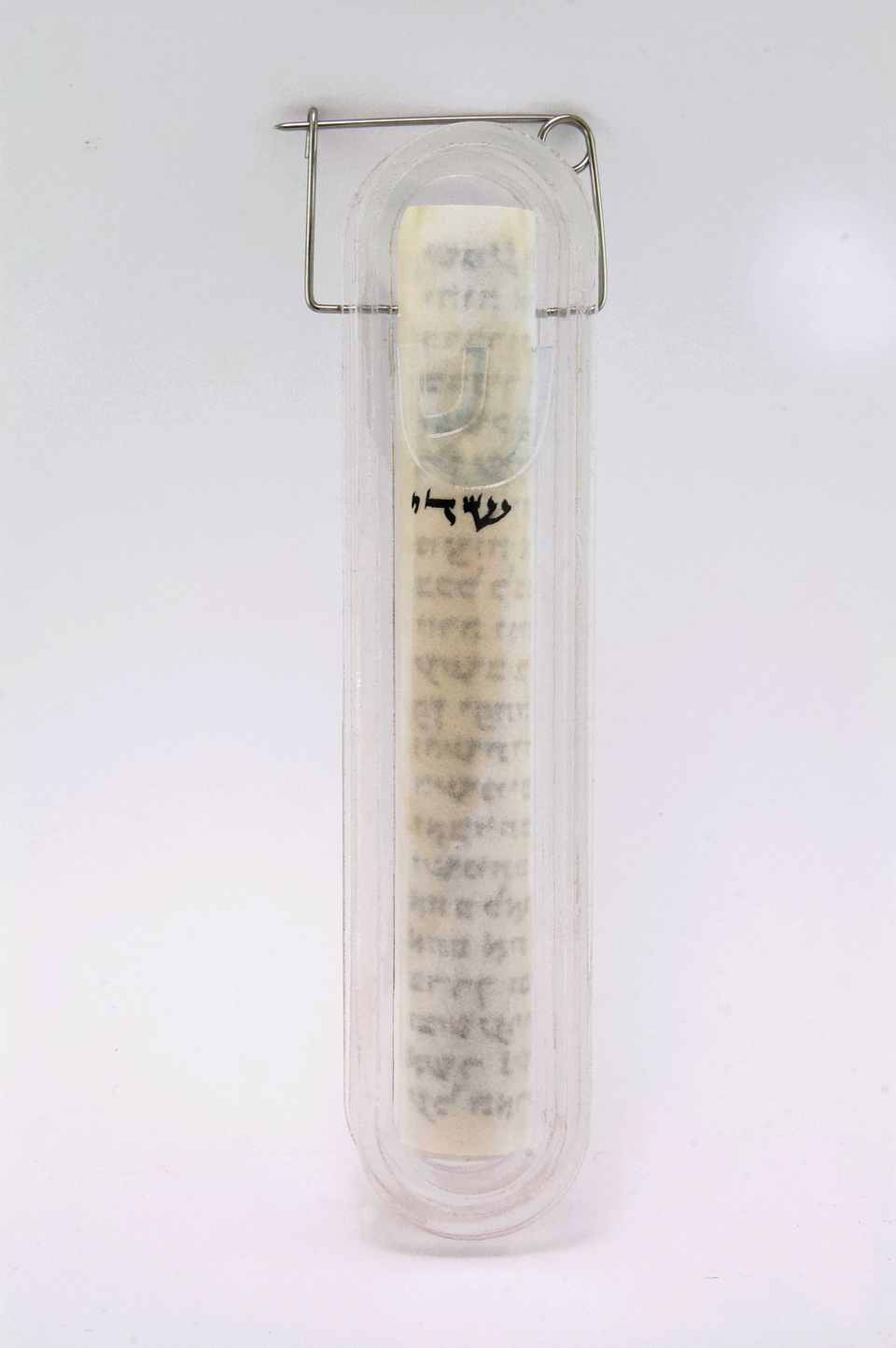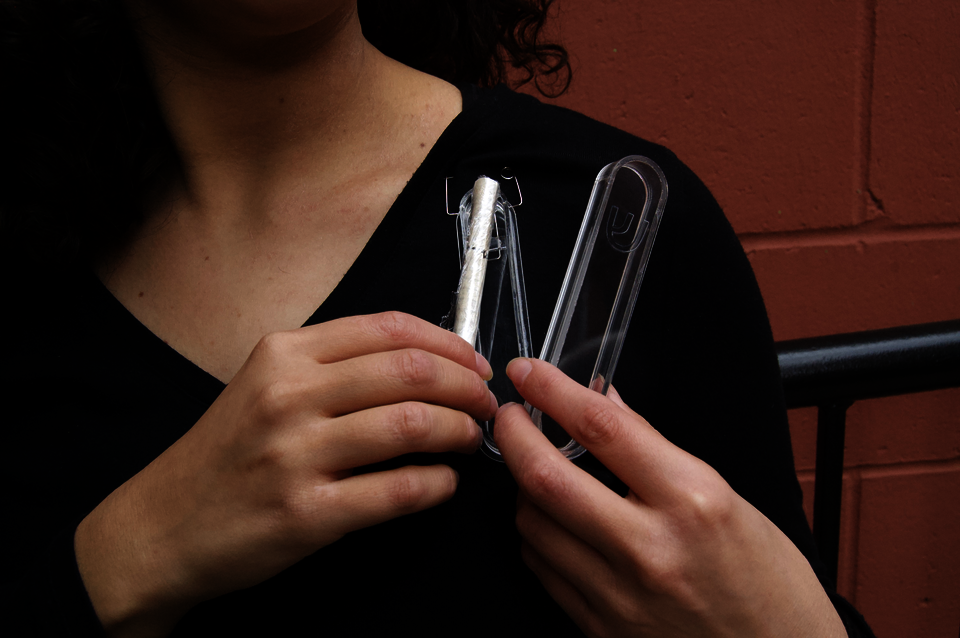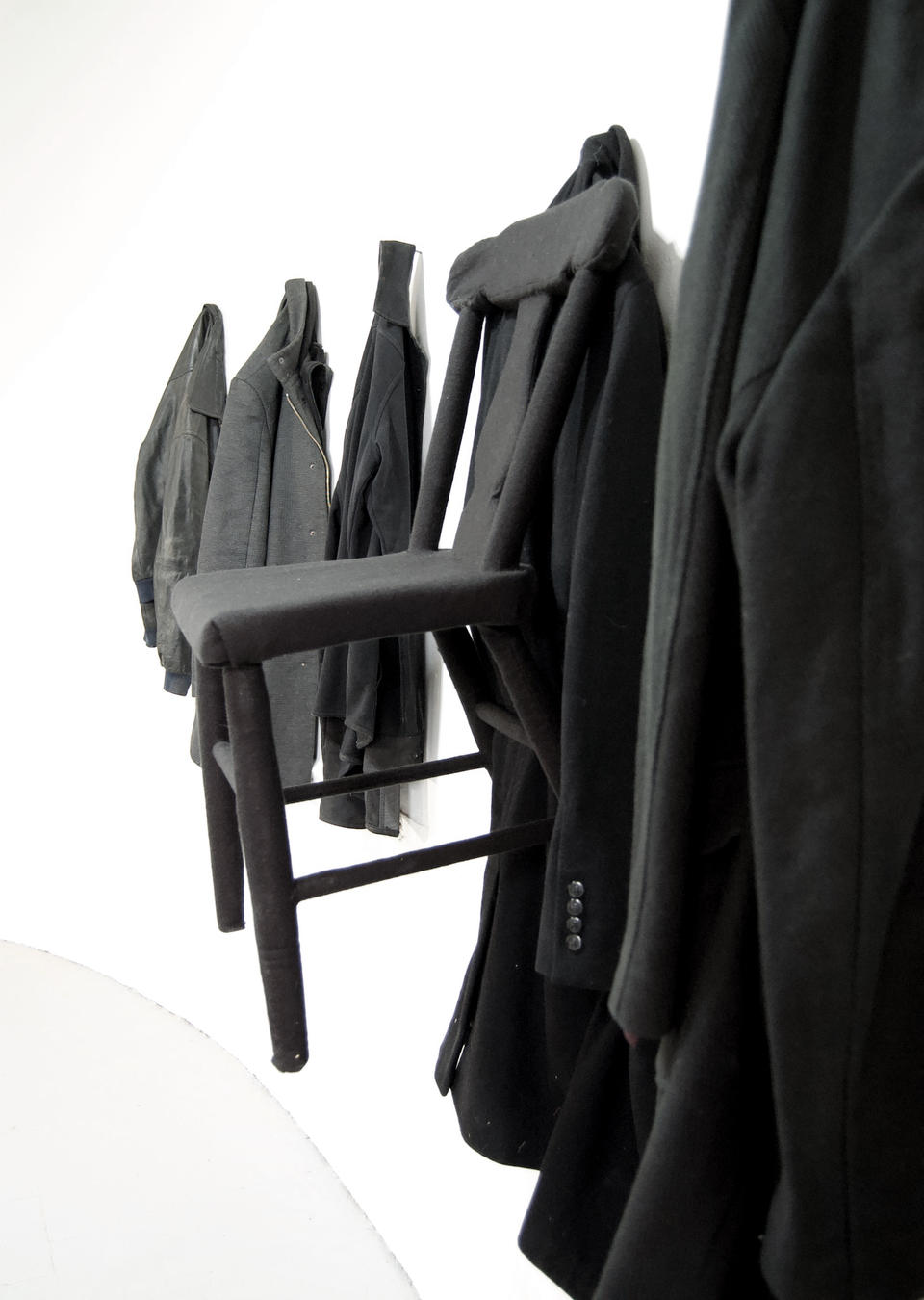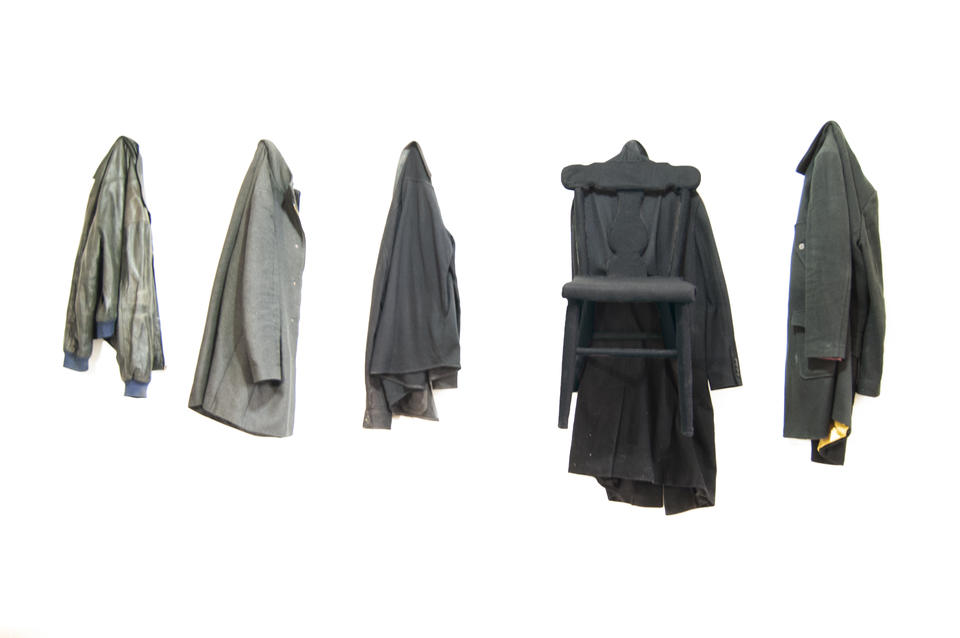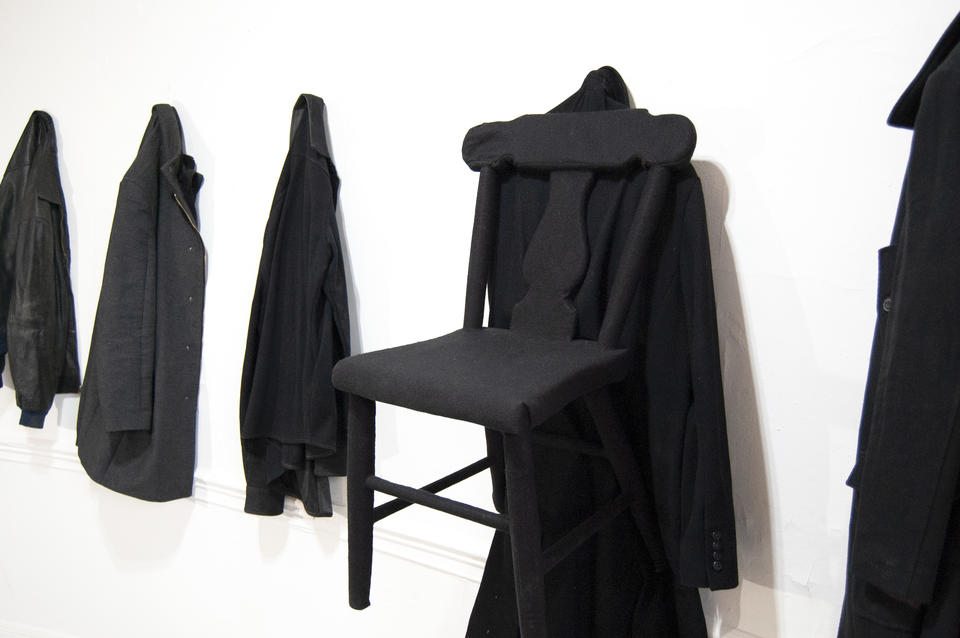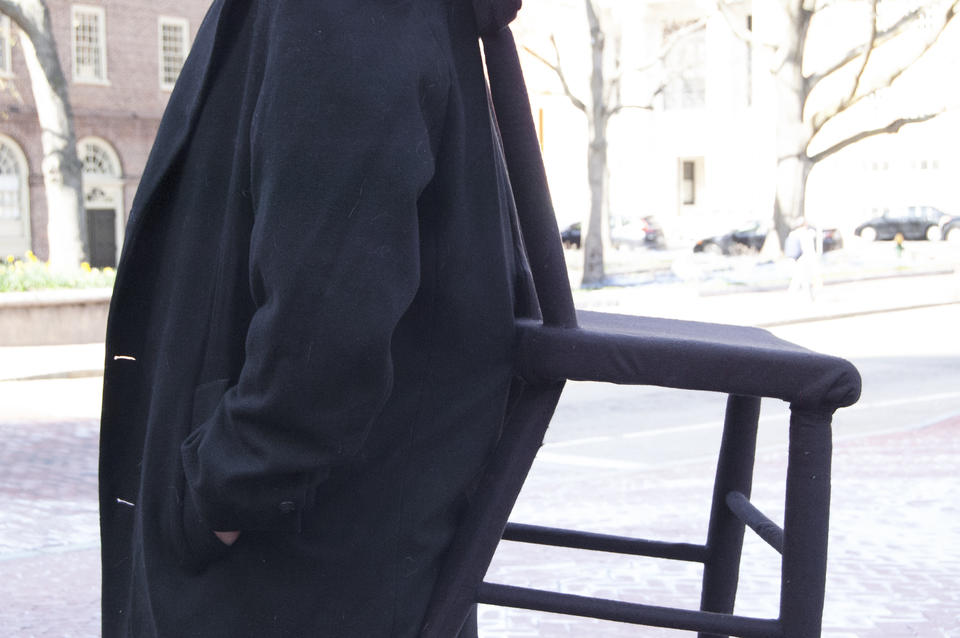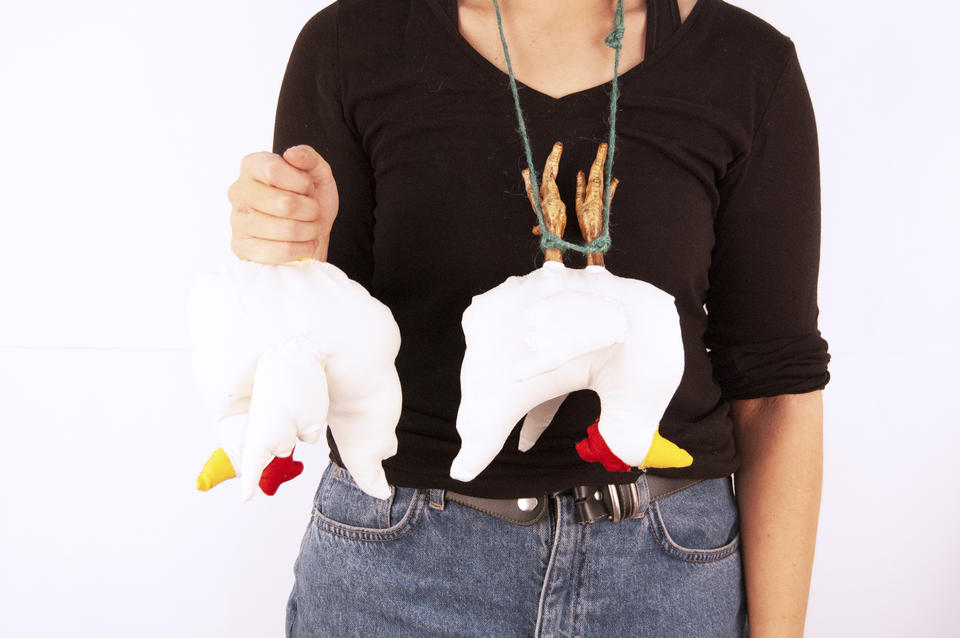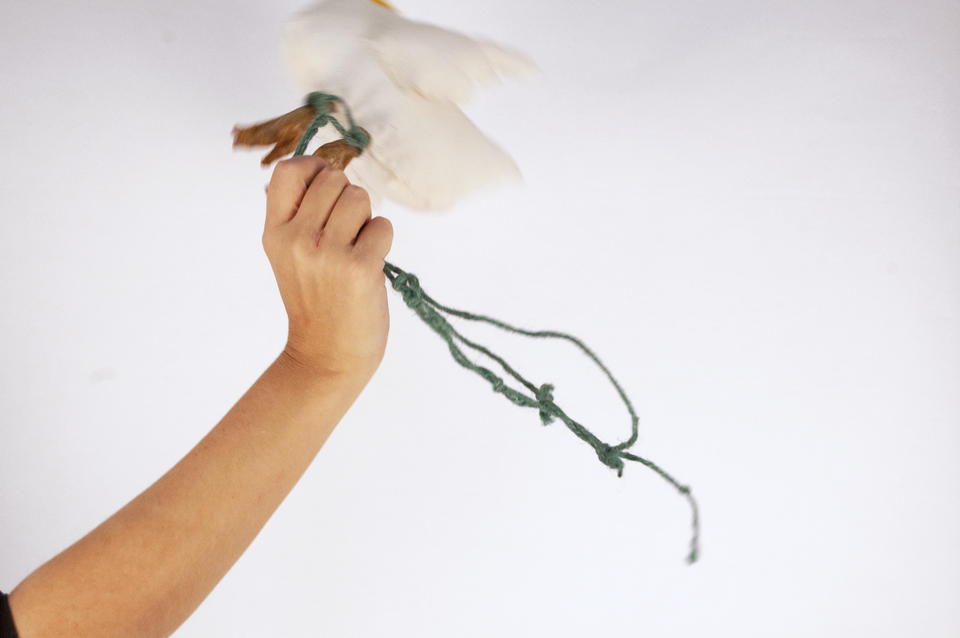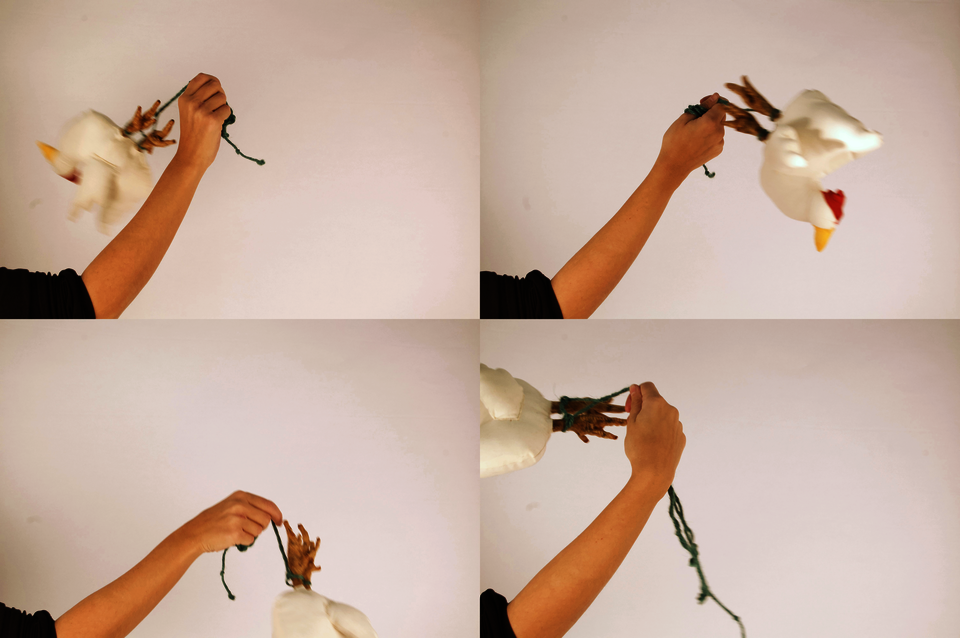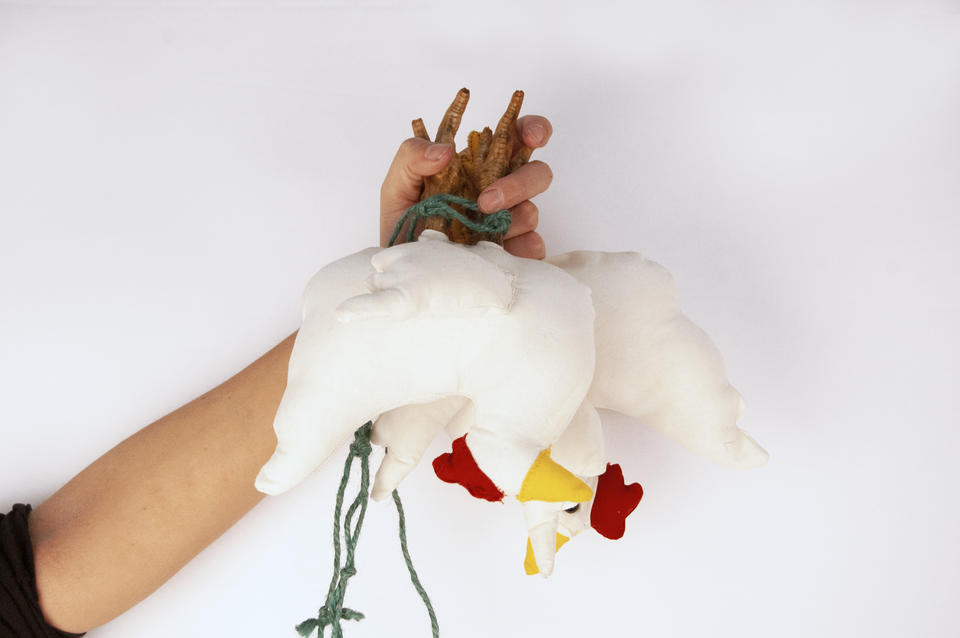ABSTRACT
A heated argument is taking place, and has been for thousands of years. We deliberate to voice our own opinions, to prove what others have declared, and to validate the past. Judaism – a culture bound by millenia of traditions – follows countless rigorous customs and laws. These traditions are strictly adhered to, and observant members of the faith go through great lengths to show their devotion to their beliefs. Although these laws and customs generally remain uninterrupted over the generations, they can occasionally be challenged by new ideas, new concepts, or new technology. Debates form around these novelties, and generate new interpretations of old conclusions. Institutions such as historical religions – which rely heavily on past events to sustain and progress their existence – cannot casually alter their practices. Doing so would discredit the believers of the past and undermine the observant followers in the present. Yet debate persists and permeates Jewish culture, and even lays the framework for modern concepts and ideas.
“Reverence for the traditional has always been deeply rooted in Judaism, and even the mystics, who in fact broke away from tradition, retained a reverent attitude towards it…”
Gershom Scholem, Major Trends in Jewish Mysticism
My thesis body of work examines several pervasive customs in contemporary Judaism and proposes new objects to aid their implementation into daily life. These objects are meant to spark debate and controversy and to be analytically dissected. They exist both as viable solutions to seldom considered problems and as catalysts for discussions that may otherwise never surface.
How do religions exist in an increasingly secular and individualized society? It is clear from looking at major faiths such as Judaism, Islam and Christianity, that the followers of such are not a stagnated people. Followers of major faiths, and Judaism in particular, seem capable of living in two moments at once: the past, and the ever shifting present. Ritual laws created thousands of years ago were sensible to those living in that time, but today can be interpreted as nothing short of restrictive for restriction’s sake.
CARRYING
This is illustrated in the rule against carrying an object outside of your home during Shabbos (A Yiddish and popularized spelling of the Sabbath or Shabbat). This rule was established and implemented to keep people from performing strenuous labor during Shabbos and is derived directly from number four of the Ten Commandments (Remember the Sabbath day; to keep it holy). Tasks like gathering firewood or moving stones to build a fence would have been — and still are —forbidden on this day. When you consider that Shabbos is intended to be a day of rest free from work, these restrictions make sense. Physically strenuous activities like the gathering of firewood would have been postponed until the next day, offering a break from the demanding chores of daily life, and allowing the individual time to reflect on the previous week.
The prohibition didn’t (and doesn’t) end at physically laborious tasks. The restriction is on carrying anything, and this can range from the aforementioned large, heavy field objects to the smallest things carriable. Stooping down to pick up an interesting stone was and is forbidden to the same capacity that hoisting a large branch over your shoulder would be. This rule applies only to things being carried outside the home; carrying objects indoors is completely permitted. This would have been drastically easier to abide with several thousand years ago, before the invention and popularization of items like house keys and pocket bags. Today, leaving our homes without carrying anything at all (including in a pocket) seems unimaginable. Keys, wallets, medication, and even small children are not permissible to carry outside the boundaries of your property.
Carrying objects is an integral part of living, and so there have been countless solutions offered attempting to make this restriction less prohibitive. These solutions exist as substitutions to the original ban, allowing life to go on as necessary while still fulfilling the spiritual and religious aspects of the law. For example: the simple house key. In most places, leaving your place of residence unlocked while you go to religious services or even on a walk around the neighborhood is entirely unsafe. There’s the option of leaving the key under a mat or elsewhere hidden on your property, but this is similarly unwise and seems a tremendous risk, especially if it becomes your weekly habit to do so. The accepted solution to this problem is called an eruv. The word eruv (עירוב) literally translates as ‘mixture’. It is a method of mixing the private and public domain so that carrying objects outside the home is permitted. It exists most commonly as a thin length of filament (similar to a strengthened fishing line) that stretches around the boundaries of an observant Jewish neighborhood. It is often affixed to telephone poles, and is discreet enough to be overlooked entirely by those who don’t know it is there. The eruv acts as a wall around the neighborhood, changing the streets and sidewalks from public to private. As the restriction on carrying exists only in the public domain, objects are now able to be transported without being considered burdensome.
JEWELRY
However, many observant Jewish people live in areas without an eruv, due to lack of demand (they may live in an area with few other Jewish people) or controversy (many eruvim have been hotly contested in recent years due to perception as being an infringement upon the separation of church and state when installed on public land). So, the question becomes: How do I take my house key with me when I leave my house, without carrying it? To answer this, we need to understand exactly what carrying is defined as. Clothing and shoes are always permitted, but to place something in the pocket of one’s clothing is prohibited. From this, it can be extrapolated that carrying is not the same as wearing. Wearing clothing is necessary and required in all circumstances to all people in a way that carrying objects could never be. Jewelry too, is permissible and is considered to be worn, not carried. A wedding ring doesn’t need to be removed and left at home on Shabbos because it is not being carried, it is being worn and so becomes a part of your body. This is because jewelry is created with the intention of being worn, the same way clothing is. Intentionality makes a tremendous impact here, as an object with no apparent ties to the body cannot be granted the title of ‘wearable’. A book balanced on top of a head therefore is not worn, it is carried, even if it never comes into contact with the carrier’s hands.
Image

Feminine Eruv
Silver, mono-filament
2020
Image
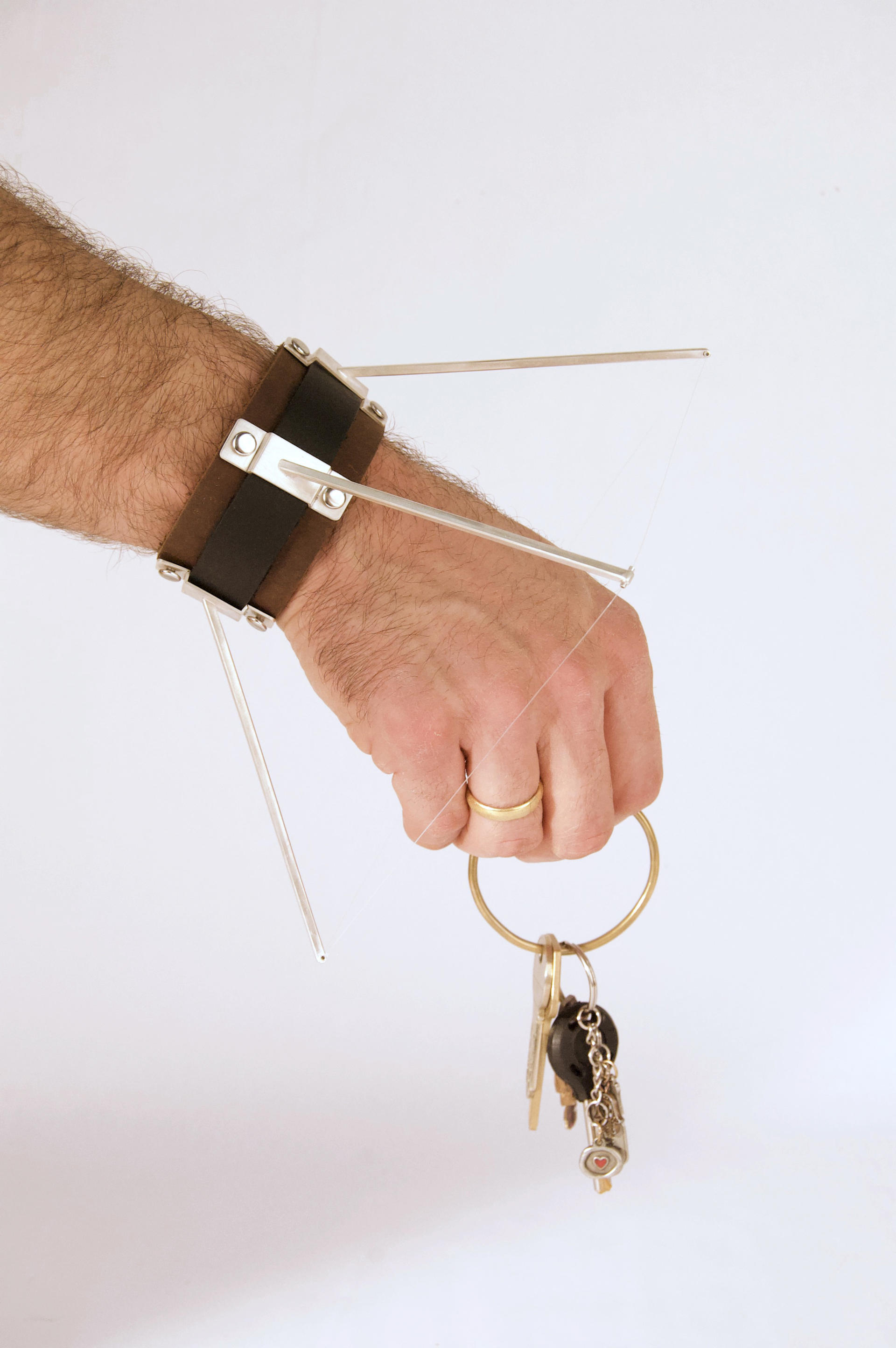
Masculine Eruv
Silver, leather, mono-filament, findings
2020
My Portable Eruv series intensely considers these specifications, and exists as wearable pieces of jewelry that extend the private domain onto the body. A thin length of filament wraps around the four silver posts attached to a main bracelet. This filament encircles the hand (or finger in the case of the EruvRing) and grants the body parts within it the carrying power of the private domain. With these pieces of jewelry, the wearer cannot carry things with their entire body, only with whatever is within the confines of the eruv. If worn on the left hand, the right hand is still prohibited from carrying. If worn on a single finger, the rest of that hand is similarly immobilized. This is plausible through halacha because the objects are clearly intended to be jewelry. Crafted primarily from silver, I have referenced classic and modern jewelry forms in the design of this mini-series. With a tiny hinge and a delicate safety catch, the Feminine Eruv cannot be misconstrued as anything other than jewelry. Likewise, the Masculine Eruv combines silver and leather, and features heavier, slightly larger components.
There are dozens of laws and regulations delineating the specifications about who can wear each specific type of jewelry. Men are not permitted to wear jewelry that is considered to be only for women, and vice versa. For example, a line in the Shulchan Aruch states that, “A woman may not go out with a signet ring; and if she does go out with it, she is liable. If it has no signet, she should not go out, but if she does she is exempt.” This restriction is because a signet ring is traditionally only worn by men, a powerful symbol depicting the family name or crest and suggesting importance and social influence. Since there was no need for a woman to wear a ring like this for most of history, it is not considered a female jewelry item and women are prohibited from wearing them on Shabbos. Another common halacha is the prohibition on women to wear certain types of adornments out of concern they will remove them to show their friends. A man was not considered likely to commit such an infraction, and so is permitted to wear those adornments. As stated in Mishna Shabbat 6, “Even if it is considered an ornament, there is still concern that she might remove it and carry it in her hand in the public domain, which is prohibited by Torah law.”
As these rules emphasize the gender division in historical and contemporary Judaism, it is important that the pieces I make also acknowledge and consider this divide. My Portable Eruvs cannot be made in a unisex design, as then they might not be considered jewelry at all if the ‘wrong’ person is to wear them. By creating two different styles of eruv bracelets I assure that they will be definitively viewed as jewelry, and will therefore be subject to rules considering such. Titling them ‘Masculine’ and ‘Feminine’ as opposed to ‘Men’s’ and ‘Women’s’ acknowledges the traditional gender division without confining the work to being categorized as such.
`We are still carrying on the activity of the rabbis of old who traced their authority through a chain of tradition to Moses and the elders . . . even though in many points we interpret our Judaism in a manner quite different from theirs. We are justified in considering ourselves the latest link in that long chain of authoritative teachers who carried on their activity of teaching, preserving and developing Judaism, and for our time we have the same standing as they had...’
Jacob Lauterbach
The above quote illustrates the Jewish hesitation to change any form of tradition, lest they undermine scholars of the past. Most customs, practices, and even laws in Judaism have been added to and adapted over the years. A surprising number of laws are not explicitly stated in the Torah, but have been deduced and instituted by rabbis, scholars, and prophets of the past. These individuals were considered so knowledgeable and connected to their faith that their interpretations of what is written in the bible have been accepted and authorized as law in their own rights. These are known as rabbinical laws. Some interpretations have been so assimilated into Jewish culture over hundreds of years that it is surprising to many individuals that the laws cannot be found anywhere in the Torah, only in subsequent holy writings.
Many of the laws and substitutions already in place in Jewish culture relate directly to the body, and I focus primarily on that relationship, examining how it can be emphasized or dramatized. The pieces I make have the potential and expectation for both interaction and discussion. They revitalize and revive traditions that may seem taken for granted. Jewelry lends itself to works of art relating to the body, but more than that it is already an important part of the biblical laws I am trying to reflect upon. There exists page after page of rules and laws regarding the specific types of jewelry a man can wear versus a woman, or a rich person can wear versus a poor person, or at which times of the year certain adornments are acceptable.
A significant part of the development of this body of work was the consideration of the reactions from my audiences, and what the range of those audiences would be. These pieces are not intended to offend, but to offer a reexamination of what might, to some people, be considered the mundane. Several practices that I examine already have established and accepted ‘solutions’; these I accentuate and manipulate. Other substitutions I create entirely based on what I feel is needed. Some of these new solutions I am proposing may seem ludicrous and ridiculous, seemingly never to be accepted as a viable alternative to the biblical restriction. However, when paired with the current and historically accepted customs, viewers understand, consider, and scrutinize the reality of what is already in usage. People become disgruntled when change is thrust upon them if that change offers that individual little benefit, identifying with the old adage, “If it ain’t broke, don’t fix it”. Because of this, my pieces offer a clearly recognizable benefit to the observant Jewish community. Though they may not be particularly convenient in a general sense, they are more convenient than living a truly biblical life.
Although my intention is not to offend, I recognize that as being a possible outcome for some audiences. I ward off this offense by promoting the work as an introduction of the new, rather than a criticism of the old. I am not suggesting that with pieces like the Wearable Eruv series that traditional eruvim are no longer necessary; rather I am simply introducing a novel and possible alternative to what already exists. With the introduction of a hypothetical piece such as this, debate is sparked, precedence is reviewed, and ultimately an outcome is decided upon. This dissection of the hypothetical is already intrinsic to Jewish culture, but is this time manifested in physical objects and ideas as opposed to verbal conversations and debates. I view the body of work not as asking ‘Why?’, but as asking ‘Why not?’ In this sense, my work can be regarded as additions rather than as replacements.
RESEARCH AND DEBATE
A considerable amount of my research has been delving into specific texts relating to halacha (Jewish law), and commentary regarding it. This is where I can see the actual biblical restrictions, how they are interpreted, and how those interpretations have been reinterpreted. I am able to see the exact requirements for building a hypothetical substitution to a law and can be sure that the object or concept I am proposing would be valid and kosher. Through considerable consultation with rabbis, non-rabbinical modern Orthodox Jews, and self-identified secular Jews, I ensure that my solutions are lawfully sound and that they are also as inoffensive as possible. The biblical commentary I am considering is important not only for the reasons mentioned above, but also because the layers and years of commentary are essentially scholars debating each other throughout history. Even within the subject of what types of jewelry a woman can wear on Shabbos, there are many differing viewpoints and opinions, making pinpointing an authoritative rule difficult. Different sects of Judaism adhere to different interpretations of a law, and rabbis and sages throughout history have fiercely debated each other for the ‘correct’ interpretation. Many of these arguments are refuted later in history by subsequent scholars and figures, and then again transformed and rebutted several centuries later. Debates and arguments are an important part of Jewish culture and history and even in regular daily conversation, certain cultures are more prone to linguistic arguments than others. ‘Cooperative overlapping’, which is described by linguist Deborah Tannen as: “...talking at the same time without interrupting; exaggerated paralinguistic features such as dramatic changes in rate of speech, loudness, and pitch; and frequent storytelling in which the point of the story is dramatized rather than stated and tends to be about personal feelings.” This linguistic phenomenon is commonly used to generalize the ‘argumentative New York Jew’, instead of being recognized for what it is: a social celebration of enthusiastic interest in the conversation around you. Thus the spirit of debate not only permeates our studies and academic endeavors, but exists in the very manner we communicate with our peers. To speakers unfamiliar with cooperative overlap, this method of speech is quite often considered rude and brash. However, the opposite is usually true, as overlapping in Jewish conversation shows genuine engagement and interest in the topic of the discussion.
There are always hypothetical questions being raised, sometimes absurd ones, in the interest of finding an answer and coming to a conclusion. Research and documentation and imperative in these hypothetical situations, as they are necessary to back up the argument. Even in the most bizarre of hypotheticals, if there is enough evidence to back up your claim, there is no reason why it won’t be accepted as admissible. An example of this is the following exchange, found in Menachot 37a of the Talmud:
Pelimo asked Rabbi: "If a person has two heads, on which should he place his tefillin?
He said to him: "Either get up and go to exile, or accept upon yourself excommunication."
In the meantime, a man came by and said: "A child was born to me with two heads. How much do I have to pay to the kohen [for the redemption of the firstborn]?"
This exchange shows that although we might initially scoff or dismiss an outlandish hypothetical as having no place in an academic discussion, there is always value to considering and interpreting it as a valid concern. Similarly, the pieces and scenarios I create are admissible as long as there is evidence to back up their validity. Since I am bringing things out of the hypothetical by actually creating these solutions and objects, they are undeniably more impactful and memorable than intangible ‘maybes’.
The work itself is a collection of stand-alone pieces that provoke reflection and self-assessment. I am not personally suggesting that any of the objects I make be used or sold, only that they could be. By blurring the line between absurdity and practicality, introspection is inevitably approachable. Through the development and iterations of these pieces, many ‘whys’ and ‘why-nots’ have been phrased. These questions have propelled the work forward, and the process of asking them has become an integral part of the final works.
“Debate and disputation are not only encouraged within Judaism, they are at the heart of Jewish history and theology. As such, I believe that a chronicle of great debates, like those presented in this book, is central to understanding the history of Jewish ideas.”
Rabbi Barry L Schwartz
This is a body of work requiring explanation to many audiences, and I assume the responsibility of providing that explanation. Works of art dealing with a particularly niche subject matter should not be exclusively understandable to the individuals who have prior knowledge of the subject. It is my job as the artist and practitioner to elaborate and explain to my target audience exactly what it is I am conveying. In my process to inform without coddling, I am privileged to learn how these traditions appear to those who have never before experienced them. This is similar to my end goal of introducing new objects or customs to traditions that haven’t yet been established. I offer to the audience the opportunity for introspection, the promise of debate, and the elation of the unfamiliar.
BODILY MEZUZOT
A mini-series within this body of work exists as ‘Wearable Mezuzahs’. A traditional mezuzah is a small scroll of parchment upon which a blessing called the Shema is handwritten by a scribe. This scroll (called a klaf) is housed in a protective case commonly made from wood, plastic, metal, or glass, and affixed to the right side of a doorway of a Jewish residence. They should be placed in every doorway in the home, including the main entrance, a living room, a bedroom, a study, or a kitchen. They are not placed in a bathroom or in a closet, as the former is considered unclean and the latter not considered to be a living space. These scrolls offer a form of protection over the home and those that live inside of it. In fact, during the Middle Ages new additions were added to the written lines of the mezuzah scroll, intending to offer even greater protection to the owner. These were often the names of angels or certain Torah verses, and the practice was discarded after Maimonides protested, being recorded as saying,
"There is no harm in writing on the outside; but those who write on the inside the names of angels, or holy names, or verses, or other formula, are of those who will have no share in the future world. For these fools not only defeat in this manner the fulfilment of a great commandment which has for its end the remembrance of the unity of God, and the love of Him and worship of Him, but turn it into an amulet for their selfish interest, believing in their foolish hearts that it can be made to serve the preservation of transitory worldly goods."
The power of these ritual objects is clear in this quote, as the denial of a share in the world to come (a concept similar to the Christian heaven) is a particularly powerful image.
They also offer remembrance of the relationship between the Jewish people and G-d, whose name is indicated by the letter ש (pronounced ‘shin’) on the outside of the mezuzah case. By placing these scrolls on the body as jewelry objects, I suggest that the body is a residence as a house is. This idea already exists to an extent in Judaism, where the body is considered to be ‘on loan’ from Hashem (G-d). The body is considered to be a container for your nefesh (soul) and not yours alone. It is from this notion that the well known Jewish taboo of tattoos and certain piercings comes from. Since you (your soul) are ‘renting’ your body and will have to return it (at time of death), you are asked to make no permanent changes to it. My WearableMezuzahs take this idea to a literal sense, and view the body as a direct residence for the soul and the individual. If we put a mezuzah on our brick-and-mortar residences, which protect us from the elements and other dangers, why wouldn’t we put them on our skin-and-bone residences, which protect us from all else?
These brooches grant the wearer the same protection outside the home as they have inside, extending the object as a talisman. They also provide a person without a home the mitzvah of having a mezuzah. The Jewish people are historically a nomadic people: we have been moving from place to place for thousands of years. An entire holiday, Sukkot, is dedicated to this nomadic lifestyle, during which we build temporary outdoor dwellings that reflect those used in ancient times. The transient nature of our people isn’t confined to biblical times, and Jews have been forced out of countless countries and cities in the past few centuries, up to and including today. As we reside in the diaspora, the idea of a mezuzah that grants protection affixed to our bodies and not a building starts to make even more sense. We have, for generations, been ready to leave a place at a moment's notice, and in more recent generations, been ready to hide just as quickly. With migration compiling an important part of our identities, mezuzahs attached to our physical beings seem indisputably relevant.
Mezuzot
ChairCoat
Some of my work deals with popular and well known laws – eruvs and mezuzahs are both superbly well known pieces of Judaism. Others deal with more obscure and lesser known laws. One in particular found in Shabbos 19:17 tells us we cannot wear furniture on top of our heads as protection against the rain. This is because the furniture is not intended to be used as protection from the rain, and so it is considered to be carried and not worn.
Commentary on Mishneh Torah, Shabbos 19:17:
“We may go out wearing coarse materials for protection from the rain even though they are not usually worn as garments. We may not, however, go out wearing furniture, utensils or mats as protection from the rain. (These are not garments at all, so he would be considered to be carrying them.) If the bedding is soft and thin the way that garments are, one may go out wearing them as a turban on Shabbos; if they are firm, they are considered to be a burden and one may not wear them in this fashion.”
My piece ChairCoat addresses this law and combines the furniture with garment, eliminating the division between the two items. The chair is the coat, and vice versa. They cannot be removed from each other, and so an individual needing to wear a heavy coat as protection from the elements can now choose to transport a chair if they so desire. The chair is covered in the same black, unassuming fabric as the coat is made of, blending them together to be as visually inseparable as they are physically. Once the individual gets to their desired destination, the ChairCoat is removed and placed on the ground, becoming a usable chair once more.
The black coat I chose to use for this piece is a strong reference to the black coats commonly worn by Orthodox Jewish men. These coats are often used as an identifying generalization by non Jewish people. The traditional reason the coats and hats are black is because the color black in clothing does not usually draw a lot of attention to itself, leaving the wearer and those around him to focus on other things.
Terms like ‘the black coats’ or ‘the black hats’ in areas like Brooklyn serve to divide the Jewish and secular communities from each other, creating a sense of ‘us’ and ‘them’. Secular Jews and goyim (a non-Jewish person) use signifiers such as these to uphold this division, and to separate their lives from the seemingly indiscernible number of black-clad haredim (observant Jew). Haredim wear long black coats for many reasons, including modesty to other people and respect to Hashem. A long garment is considered respectful, and while some chose to wear them only on particular events like Shabbos or a holiday, many Jewish men choose to wear them on a daily basis, particularly the Ultra-Orthodox and Hasidic sects of Judaism. These coats (almost always accompanied by a stylized black brimmed hat) are a symbol of belonging to the community, and are a ritual that shows solidarity with others in their social sphere. My ChairCoat breaks the traditional silhouette of the black hat and coat, which can serve to distinguish the individual who wears it from their peers, or bring attention to a manner of dressing that is designed to blend in.
Image
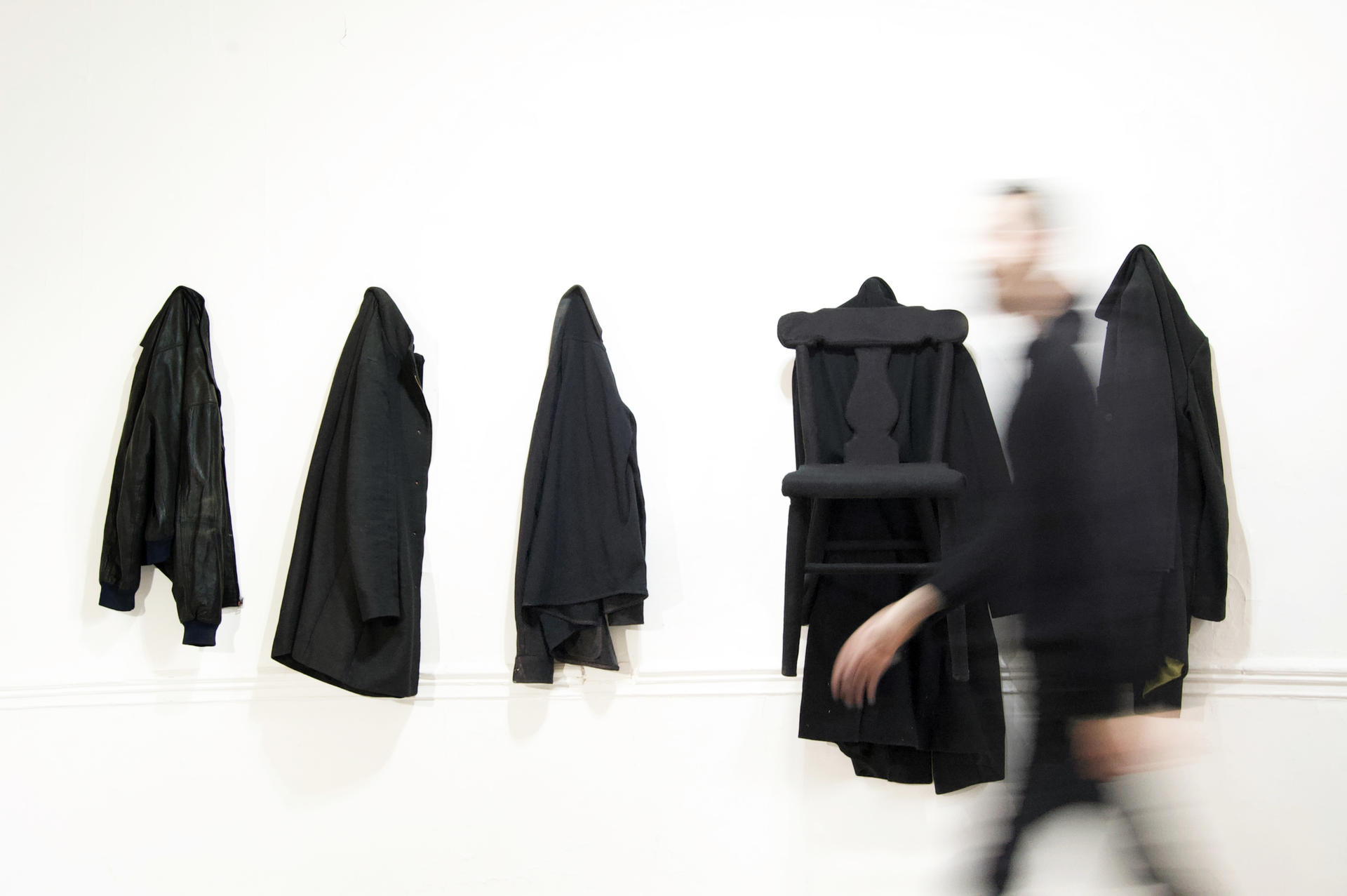
Image
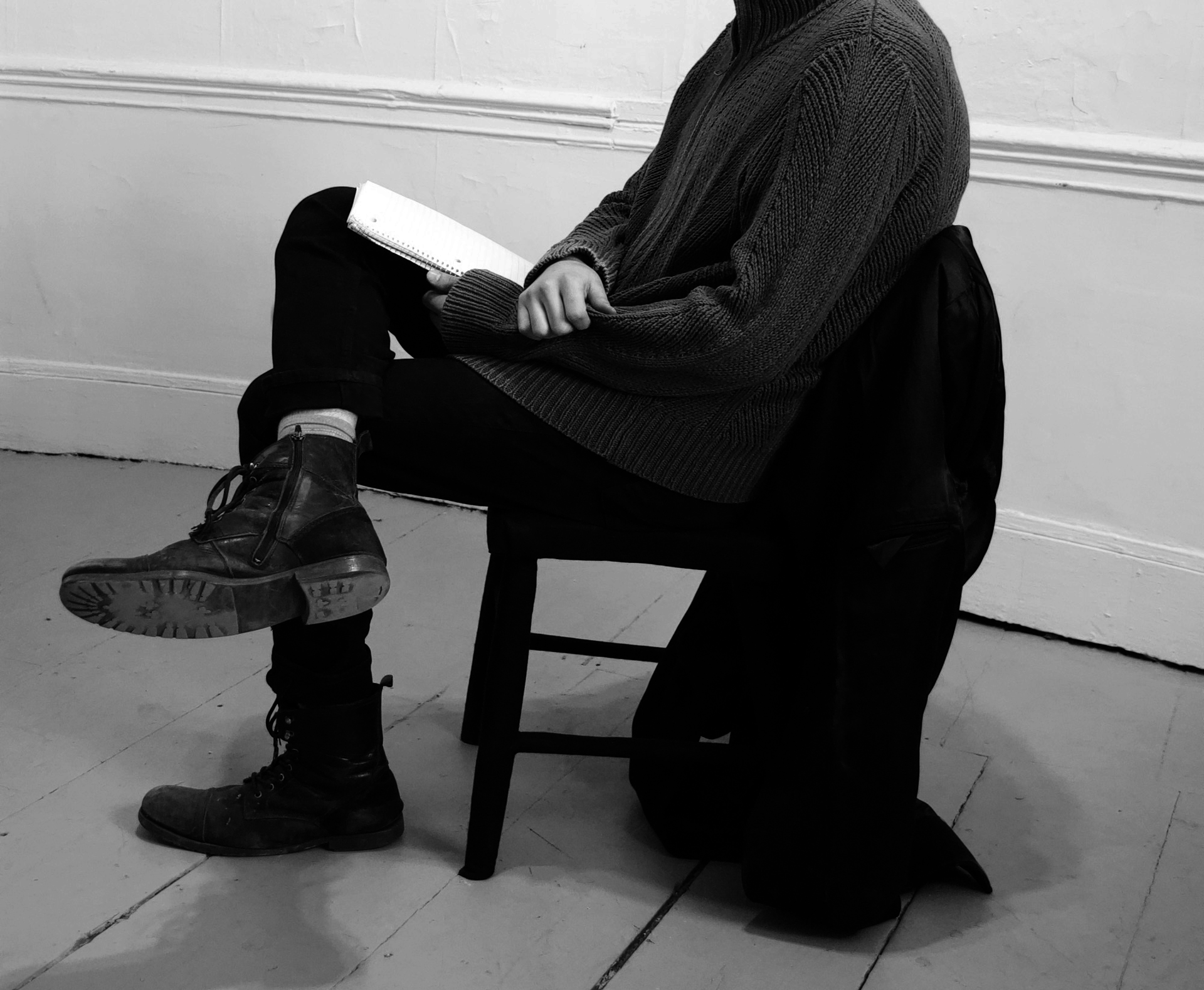
ChairCoat
Device for Signaling a Goy
Some other Shabbos restrictions include switching on a light, switching off a television, tearing toilet paper, squeezing a tube of toothpaste, and handling money. There are actually 39 different categories of work that are prohibited during Shabbat, called the ‘39 Melachos’ (translated to mean ‘39 forms’, shortened from ‘39 forms of work’). These categories are:
Image
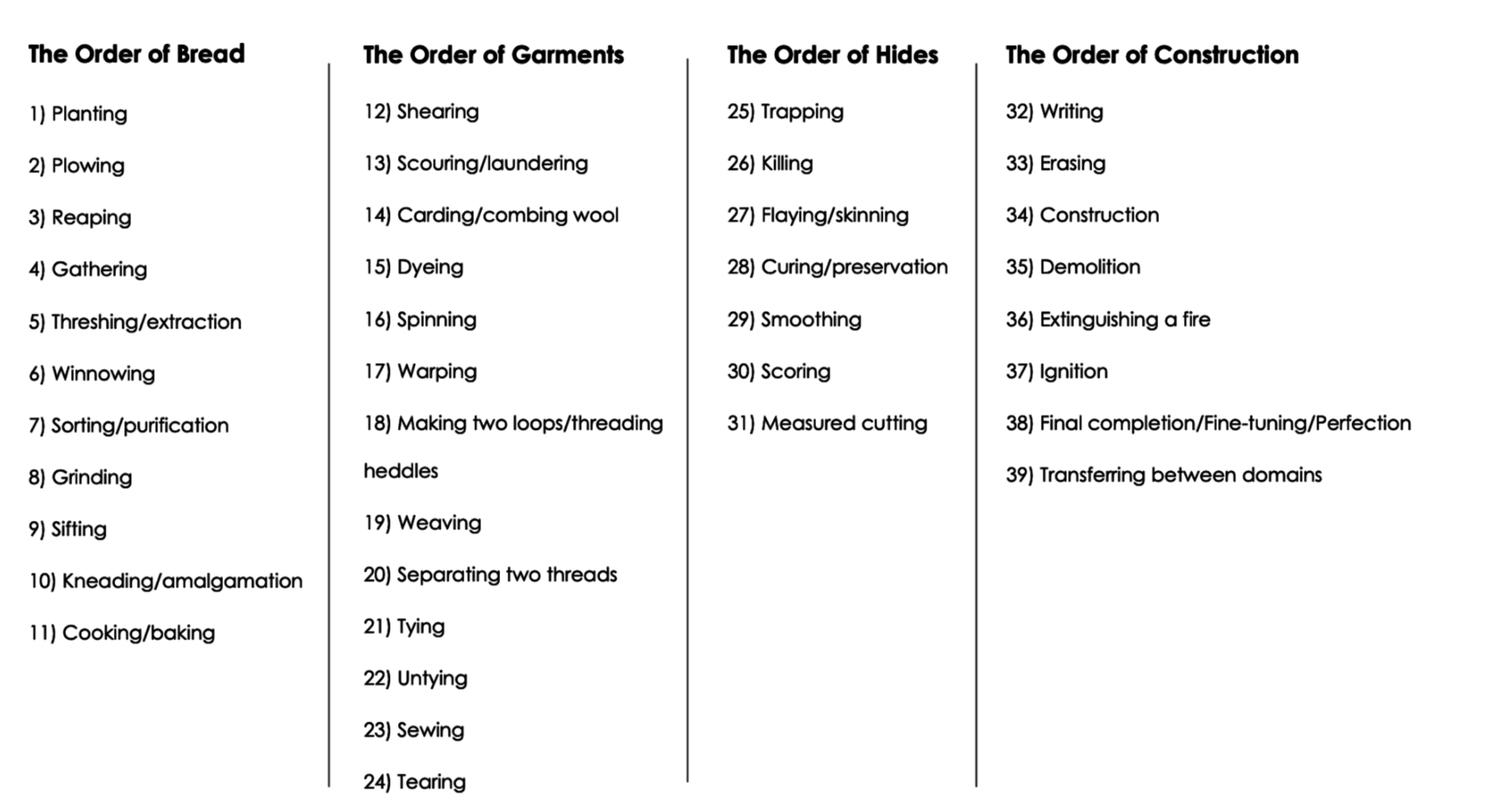
In our lives today, numbers 36 (Extinguishing a fire) and 37 (Ignition) are extremely prevalent. Turning on a light bulb is considered ignition, as turning it off is extinguishing. In fact, the use of any electric object is forbidden, and considered muktzeh. This means you must have all the lights you will need in your house switched on or off before Shabbos starts. If you leave a lamp on in your bedroom accidentally, it will be on all of Friday night, and you have no way of shutting it off. This goes for fans, air conditioners, radios, televisions, electronic children’s toys, an iron, whatever you have that has a plug or an On/Off switch. There is the possibility of using a pre-set timer for your lights and other appliances, but if you forget to set it, or set it incorrectly, it is rendered useless. Once the sun has set and Shabbos has started, a Jewish person is not allowed to perform any of the 39 Melachos, or to ask a non-Jew directly to perform them in their stead. A solution that has developed is to find a non-Jew (usually by going outside your residence and waiting till someone walks by) and heavily hinting towards the task that you want done. This is known in Hebrew as אמירה לנכרי (phonetically: Amira lincari), or ‘A statement to a foreigner’. An example of this is if you have left the lamp on in your bedroom as mentioned above, and you wish it to be turned off. You might go outside and wait till someone passes by, then get their attention and proclaim, “Oh, it’s so bright in my bedroom! I certainly wish the lamp wasn’t on, I don’t know how I’ll get to sleep tonight with all that light in the room.” The hope is that the non-Jewish individual will quickly get the message, and be willing to follow you inside to switch off the light. Since there wasn’t a direct request made, it is not considered to be desecrating Shabbos.
My Device for Signaling a Goy pushes this concept farther, and eliminates the need for any form of linguistic interaction. Although the ‘Shabbos Goy’ practice as it is known is generally accepted, there is some debate as to whether the verbal hinting is truly indirect enough to be considered appropriate for Shabbos. My flags use no true language, instead relying on simple images of popular devices that one may need manipulated on Shabbos. The flags are able to be raised and lowered from inside the house, and use no pulleys or levers that would otherwise break Shabbos. Asking Rabbi Moshe Moscowitz of Providence, Rhode Island to consider the validity of the flags, his response was that the flags on their own pose no danger to desecrating the Shabbos, and the deeper question they pose of asking a non-Jew for help would take further consideration on his part. This opinion was confirmed by Rabbi Moshe Plotkin of New Paltz, New York. In fact, the concept of a ‘Shabbos Goy’ has been contested for centuries. It is commonly accepted in areas with a large Jewish population such as New York City, but frowned upon in other places where the practice would be harder to convey to a passing gentile. The large, clear images on my flags are visible from across the street or down the block, and a passerby is easily able to assess the situation, decide whether they are willing to help, and approach the residence at their discretion. The flags can then be moved back into their passive position once the task is completed. Using the color red, which is often used for alerts and attention (stop signs, emergency exits, fire trucks), these flags are unlikely to be overlooked when unfurled, and provoke a sense of urgency to those who come across them.
Device for Signaling a Goy
Alternate Kaparot
Controversies in certain areas of Jewish traditions already exist. One example of this is the custom of Kaparot, in which a live chicken is swung around a person’s head on the evening before Yom Kippur. While the chicken is swung, a blessing is recited that spiritually and symbolically transfers all of the person’s sins of the past year to the bird, which is then sheched (slaughtered) and given to charity. In recent decades, several groups have contested the continuation of this practice due to concerns of animal cruelty. Although the hens and roosters (selected in accordance with the sex of the human) are humanely killed, they are often kept in crowded, small cages prior to the ritual. The very act of swinging them while alive is also questionable, and although it is becoming increasingly frowned upon to do so, the practice is still quite common in Ultra-Orthodox communities. An extant solution is to substitute the animal with a bag of coins, to which a modified blessing is recited, and which is likewise distributed as tzedakah (charity). There are records going back over 1000 years describing the substitutions of different animals such as ducks, geese, fish, or sheep. This was often based upon the wealth of the family or the scarcity of the sacrifice. The very practice of kaparot itself has always been highly contested, with several famous scholars from history such as the Rambam condemning it as a ‘pagan rite’ and promoting that it be abandoned. Despite this, the custom remains quite popular and prevalent every year before Yom Kippur. It is believed that the custom was popularized by Natronai ben Hilai, a well known Jewish scholar living in the 9th century. The tradition is thought to be derived from the fact that the ancient Hebrew word גבר (gever) can be used to refer to either a man or a rooster. When the bird is killed after the sins are transferred into it, it is understood from this to act as a substitution for the human who did the transferring.
With my Alternative Kaparot, I retain that important aspect in both likeness and depiction. With cotton chickens swung over the head, there is no possibility of animal abuse during the act of kaparot. Real, dried chicken feet are attached to the cloth birds, symbolizing a real chicken that was slaughtered as atonement for the swinger’s sins. Kaparot is a custom that is equally concerned with facing your own mortality, and the giving of tzedakah to those in need. My AlternativeKaparot, if ever manufactured and distributed for general use, would pledge that the chicken killed for the feet in use would be given as charity to the poor. In this way, I maintain every important aspect of this tradition, while eliminating any concern over the mistreatment of animals that is rampant associated with the custom.
Alternate Kaparot
Process and Summary
“Judaism not only maintains a great respect for debate; one could readily argue that debate is central to its religious expression.”
-Rabbi Barry L Schwartz
I am designing these objects as prototypes serving to spark debate, rather than manufacture-ready products. As they stand now, they are one-off items, functioning as introductory conversations to under discussed concepts. They hypothesize what might be, while referencing what already is. A form of design fiction, these items allow my viewers to ‘make speculations concrete’. Objects like the ones I am developing must simultaneously follow a strict and a novel process. I have hundreds of years of Jewish law to reference, with layers of commentary to supplement them. However, with the development of new objects and new concepts, there is very little in the way of specific precedence. This is where debate comes into play in my practice. I suggest something: a concept, an idea, an object, a change. I present this idea to other Jewish people and listen. I am almost always met with understanding for what I am suggesting, and a lot of questions. For a hypothetical to be considered, it needs to be built as realistically as possible. This is essentially worldbuilding; I describe the exact setting, place, time, people and materials my objects would employ. I wait for someone to fire back at me “Ah, but what if…”, and take those What-Ifs back to my studio to consider and implement. Once they have been resolved, I take them back to the Jewish public, and present them once again. Maybe my resolutions have solved the issue, or perhaps they have created several more problems that are now recognizable. My process relies on these confrontations as the basis of my research.
There is no way to separate the spirit of debate from Judaisim; as illustrated in the quote above, it can be concluded to be a fundamental cornerstone of the religion. As delineated throughout this document, there are numerous ways that debate and argument have influenced the development of customs within Jewish history. Through objects, written and verbal language, and the study of biblical resources, we see a steadfast conviction to adhere to the traditions of the past while embracing the movements in the present. Though these new concepts and ideas usually arise naturally, I found it quite effective to intentionally create these situations by use of new objects. Where debate could exist, but didn’t, I drew it to the surface by implementing my work in biblical and rabbinical context. I have been asked numerous times in the development of this body of work if I was intending to market my objects, to produce them, to sell them. I have no interest in doing this, as although I am creating objects, I am in reality creating concepts. No patents, trademarks, or labels could exist on the pieces I made as they are all prototypes for different ways of thinking about a tradition. They invite iteration and future modifications, existing as objects and jewelry second, and concepts first. I encourage any debates, arguments, contentions, controversies, disputes, or deliberations that may arise while pondering these concepts. How the work exists from now on is no longer up to me, nor should it be: I invite the Jewish public to consider them further and accept or reject these ideas as they see fit.
Endnotes
1.) Scholem, Gershom. Major Trends in Jewish Mysticism
2.) de Blois, Francois. “The Etymology of ‘Sabbath’.”
3.) Deuteronomy 5:12
4.) Wyatt Cenac. The Thin Jew Line. Comedy Central, 2011.
5.) Shabbat 62a. The William Davidson Talmud
6.) Maimonides, Moses. 1470. Mishneh Torah Sabbath 19:17
7.) Ganzfried, Solomon ben Joseph, Eliyahu Meir Klugman, and Yosaif Asher Weiss. 2008. Kitzur shulchan aruch: The code of Jewish law.
8.) Mishnah Shabbat 6:1,The William Davidson Talmud
9.) Central Conference of American Rabbis Responsa. American Reform Responsa
10.) Tannen, Deborah. “Relative Focus on involvement in oral and written discourse” in Literacy, Language and Learning: The Nature and Consequences of Reading and Writing
11.) Schiffrin, Deborah. “Jewish Argument as Sociability.”
12.) The William Davidson Talmud. Menachot 37a:7
13.) Blau, Rav Yitzchak. Shiur #29: Hypothetical Questions, Two-Headed People and the Unity of Am Yisra’el
14.) Schwartz, Rabbi Barry L. “Afterword.” In Judaism’s Great Debates: Timeless Controversies from Abraham to Herzl
15.) Jacobs, Joseph. 1906. The Jewish encyclopedia. Volume 8, page 532
16.) Dorff, Dr. Rabbi Elliot. 2015. Caring for Our bodies in Life and in Death
17.) MJL. Body and Soul
18.) Abramowitz, Jack. Commentary on Mishneh Torah
19.) Jacobs, Joseph. 1906. The Jewish Encyclopedia
20.) Jacobs, Joseph. 1906. The Jewish Encyclopedia
21.) Dubnow, Simon, and Moshe Spiegel. 1967. History of the Jews. Page 405
22.) Jacobs, Joseph. 1906. The Jewish Encyclopedia. Volume 7, page 436
23.) Schwartz, Rabbi Barry L.
24.) Gonsher, Ian. “Beyond Design Thinking”
Bibliography
1.) Abraham, Joann. “The Mezuzah: Why Isn’t It Straight?” The Mezuzah: So Why Isn’t It Straight? | Jewish Federation of Greater MetroWest NJ. https://www.jfedgmw.org/the-mezuzah-so-why- isnt-it-straight.
2.) Abramowitz, Jack. Commentary on Mishneh Torah, Shabbat 19:17. https://outorah. org/p/36438
3.) Abramowitz, Rabbi Jack. HaShoneh Halachos 2: Mishneh Torah.” OU Torah. OU, August 7, 2017. https://outorah.org/p/36437.
4.) Blau, Rav Yitzchak. “Shiur #29: Hypothetical Questions, Two-Headed People and the Unity of Am Yisra’el”. Etzion.
5.) Cenac, Wyatt. The Daily Show with Jon Stewart. The Thin Jew Line. Comedy Central, 2011. https:// www.cc.com/video/1jsrl7/the-daily-show-with-jon- stewart-the-thin-jew-line.
6.) Central Conference of American Rabbis Responsa. American Reform Responsa. 8: Ordination of Women (Vol. XXXII, 1922, pp. 156- 177)
7.) Citron, Aryeh. n.d. The Myth of the “Shabbos Goy”. Chabad. https://www.chabad.org/library/ article_cdo/aid/1140867/jewish/The-Myth-of-the- Shabbos-Goy.html
8.) de Blois, Francois. “The Etymology of ‘Sabbath’.” The Origins of The Seven-Day
Week. Lecture presented at the The Origins of The Seven-Day Week, June 25, 2015. https:// blogs.ucl.ac.uk/calendars-ancient-medieval- project/2015/07/15/the-etymology-of-sabbath/
9.) Dorff, Dr. Rabbi Elliot. ”Caring for Our bodies in Life and in Death”. American Jewish University. August 25, 2015. https://www.aju.edu/ziegler- school-rabbinic-studies/our-torah/back-issues/ caring-our-bodies-life-and-death
10.) Dubnow, Simon, and Moshe Spiegel. 1967. History of the Jews. South Brunswick, New Jersey: Thomas Yoseloff.
11.) Even- Israel Steinsaltz, Adin. The William Davidson digital edition of the Koren Noé Talmud. Koren Publishers. Accessed through Sefaria.com
12.) Fiks, Yevgeniy. Is There a New Yiddish Contemporary Visual Art?. Hyperallergic. 2020. https://hyperallergic.com/581286/is-there-a-new- yiddish-contemporary-visual-art/
13.) Freeman, Tzvi. n.d. Do I Have To Buy My
Wife Jewelry? Chabad. https://www.chabad.org/ library/article_cdo/aid/965909/jewish/Do-I-Have- To-Buy-My-Wife-Jewelry.htm
14.) Ganzfried, Solomon ben Joseph, Eliyahu Meir Klugman, and Yosaif Asher Weiss. 2008. Kitzur shulchan aruch: The code of Jewish law.
15.) Gonsher, Ian. “Beyond Design Thinking” (2016). Articles. 15. https://digitalcommons.risd. edu/critical_futures_symposium_articles/15
16.) Greenblatt, Yitzchak. “Going Out On a Limb .” Ohr Somayach, November 15, 2014. https://ohr. edu/this_week/its_not_quite_that_simple/6093.
17.) Hidary, Richard. The Right to Bear Arms and Bare Fingers. Tablet Mag, October 28th, 2020. https://www.tabletmag.com/sections/belief/ articles/right-to-bear-arms-shabbat-talmud- hidary
v18.) Hoffman, Yaakov. “Jewelry on Shabbat: Pretty or Prohibited?” Torah Musings. September 3rd, 2019. https://www.torahmusings. com/2019/09/jewelry-on-shabbat-pretty-or- prohibited/
19.) Jacobs, Joseph. 1906. The Jewish encyclopedia; a guide to its contents, an aid to its use. New York: Funk & Wagnalls Company.
20.) Judaism: the Tanakh: the New JPS Translation. New York, NY: Quality Paperback Book Club, 1992.
21.) Kulp, Joshua. “English Explanation of Mishnah Kelim 17:17:1.” Sefaria, 2013. https://www. sefaria.org/English_Explanation_of_Mishnah_ Kelim.17.17.1?lang=bi&with=all&lang2=bi.
22.) Lubow, Arthur. How New York’s Jewish Museum Anticipated the Avant-Garde. New York Times. 2020. https://www.nytimes. com/2020/07/23/t-magazine/jewish-museum- new-york.html
23.) Maimonides, Moses. 1470. Mishneh Torah.
24.) MJL. “Adorning the Body.” My Jewish Learning, April 19, 2017. https://www. myjewishlearning.com/article/adorning-the-body/.
25.) MJL. “Body and Soul”. My Jewish Learning. https://www.myjewishlearning.com/article/body- soul/
26.) MJL. “Conversation & Debate.” My Jewish Learning, December 10, 2020. https://www. myjewishlearning.com/article/conversation- debate/.
27.) Posner, Menachem., n.d. 14 Facts About the Code of Jewish Law (Shulchan Aruch). Chabad. https://www.chabad.org/library/article_cdo/ aid/4305141/jewish/14-Facts-About-the-Code-of- Jewish-Law-Shulchan-Aruch.htm
28.) Raphael Patai. “ Encyclopedia of Jewish Folklore and Traditions” Routledge, 2013
29.) Schiffrin, Deborah. “Jewish Argument as Sociability.” Language in Society 13, no. 3 (1984): 311-35. http://www.jstor.org/stable/4167542.
30.) Scholem, Gershom. Major Trends in Jewish Mysticism: the Hilda Stich Stroock Lectures, 1938. Jerusalem: Schocken, 1941.
31.) Schwartz, Rabbi Barry L. “Afterword.” In Judaism’s Great Debates: Timeless Controversies from Abraham to Herzl, 95-96. LINCOLN: University of Nebraska Press, 2012.
32.) Shurpin, Yehuda., n.d. Is It OK to Wear a Mezuzah Necklace? Chabad. https://www.chabad. org/library/article_cdo/aid/3514795/jewish/Is-It- OK-to-Wear-a-Mezuzah-Necklace.htm.
33.) Slapak, Orpa, and Esther Juhasz. “Jewish Dress.” In The Berg Companion to Fashion, edited by Valerie Steele. Oxford: Bloomsbury Academic, 2010. http://dx.doi.org/10.5040/9781474264716 .0009937.
34.) Tannen, Deborah. “Relative Focus on involvement in oral and written discourse” in Literacy, Language and Learning: The Nature and Consequences of Reading and Writing. David R. Olson, Nancy Torrance, Angela Hildyard, Cambridge University Press. CUP Archive, Apr 26, 1985

